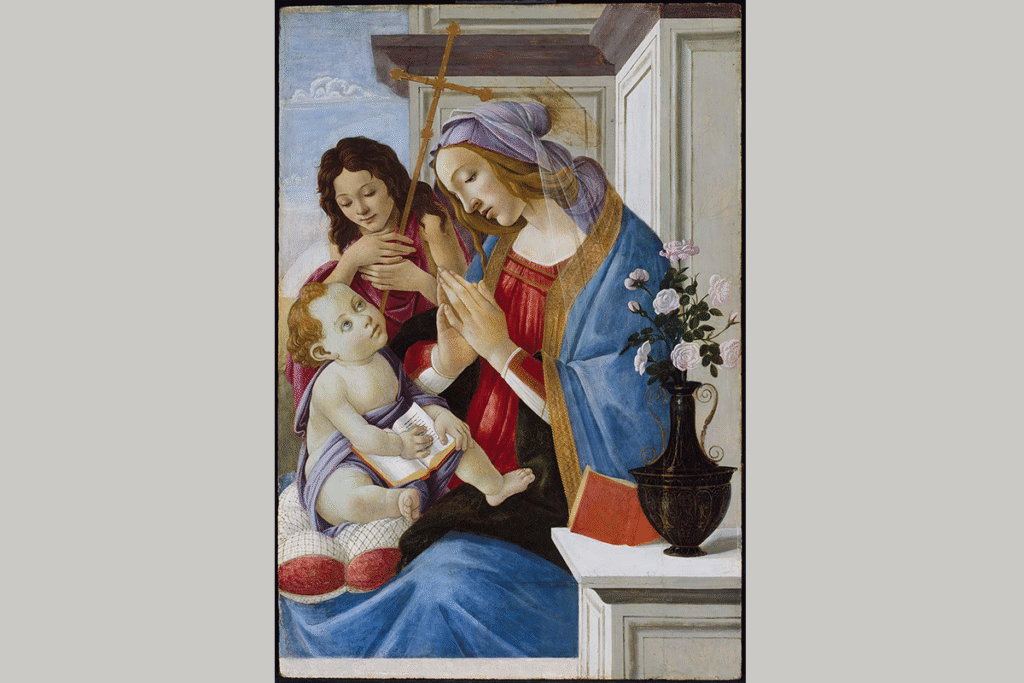Sandro Botticelli, Virgin and Child with Saint John the Baptist, ca. 1500. Museum of Fine Arts, Boston.
 At the Renaissance Gallery of the Museum of Fine Arts in Boston, there is a masterpiece that caught my attention when I visited on September 30th. This marvelous feat was a Madonna painted by the prince of artists, Sandro Botticelli, in the company of the Child Jesus and the young St. John the Baptist. Here, Botticelli depicts a harmonious scene, showing the Madonna immersed in prayer while gazing at her Beloved Son.
At the Renaissance Gallery of the Museum of Fine Arts in Boston, there is a masterpiece that caught my attention when I visited on September 30th. This marvelous feat was a Madonna painted by the prince of artists, Sandro Botticelli, in the company of the Child Jesus and the young St. John the Baptist. Here, Botticelli depicts a harmonious scene, showing the Madonna immersed in prayer while gazing at her Beloved Son.
When I first saw this painting, I was struck by the serenity, softness, and sweet delicacy of the figures, that is, mainly how Botticelli portrays the innocence of the face of the Child Jesus.
Regarding the technique, I want to highlight some remarkable aspects. Firstly, the figures are centrally placed in a triangular arrangement, creating a sense of balance and natural harmony and drawing the eye to the focal point of the masterpiece: Mary and her Son. Secondly, the linear perspective presents the figures in a familiar space, evoking a sense of intimacy. Thirdly, I want to underscore the colors, such as the blue of the Virgin’s robe. Playing with a spectrum of tones, Botticelli creates soft colors that delight the viewer and help him to have a deeper gaze and contemplative reflection.
Part of the high success of the painting is the tempera technique that the prince of art uses. “Tempera does not blend well and dries very quickly (…) working with tempera lay small brush strokes of colors side by side, a technique which allows the artist to achieve fine detail, and, by building the color up in layers, creates intermediate tones”(1). The tempera technique in this masterpiece is used to create smooth, almost translucent layers of flesh in the skin tones, particularly in the faces of the Virgin Mary and her Son.
As an important artist, Botticelli was patronized by wealthy families in Florence. Nevertheless, this masterpiece, intended for “his private devotion, possesses characteristics of Botticelli’s later manner-a certain stiffness in the profiles and drapery folds, a continued elegance as in the hands of the Virgin and Saint John, and such improvised details as the free painting of roses on top of the lilies originally sketched at right”(2).
Finally, as a brother in formation and a legionary of Christ, I can use this painting as a starting point to invite people to silence in their lives by contemplating the gifts that God has put in front of them; like Mary, immersed in prayer, and silent atmosphere, who gazes at the most important thing in her life: Jesus Christ.
Foot notes
- J. Walford, Great Themes in Art, Prentice All, China 2001, 204.
- S. Greene, MFA Boston: Virgin and Child with Saint John the Baptist, n. d., in https://collections.mfa.org/objects/31068/virgin-and-child-with-saint-john-the-baptist?ctx=ed3192c7-6cf8-4508-9418-53e944de5c02&idx=98, (Referenced on October 1st, 2024)



